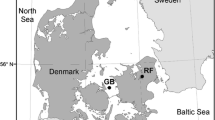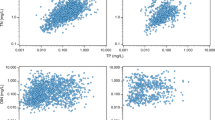Abstract
Dissolved organic nitrogen (DON) concentrations were measured in meso-oligotrophic Castle Lake, California during the ice-free season in 1982, 1983 and 1984. No consistent relationships were found between DON and particulate-N, primary productivity rates or chlorophyll concentrations. However, increases in DON concentrations were observed in the early growing season of 1982 and 1984 when water temperature was rising and a diatom bloom was senescing. DON increased at a high rate (0.31 mg atom N m−3 day−1), and then rapidly disappeared. Sediment released appared to be the most important source of DON. Dissolved free amino acids were always less than 7.5% of the DON pool, and did not vary in the composition of specific amino acids during the growing season.
Similar content being viewed by others
References
Armstrong, F. A. J. & S. Tibbits, 1968. Photochemical combustion of organic matter in sea water, for nitrogen, phosphorus and carbon determination. J. Mar. Biol. Ass. UK 48: 143–152.
Axler, R. P. & R. M. Gersberg, 1981. Vertical patterns of inorganic nitrogen uptake in subalpine lake. Verh. int. Ver. Limnol. 21: 326–332.
Axler, R. P. & C. R. Goldman, 1981. Isotope tracer methods for investigations of nitrogen deficiency in Castle Lake, California. Water. Res. 15: 627–632.
Axler, R. P., G. W. Redfield & C. R. Goldman, 1981. The importance of regenerated nitrogen to phytoplankton productivity in a subalpine lake. Ecology 62: 345–354.
Azam, F., T. Fenchel, J. G. Field, J. S. Gray, L. A.Meyer-Reil & F. Thingstad, 1983. The ecological role of water-column microbes in the sea. Mar. Ecol. Prog. Ser. 10: 257–263.
Banoub, M. W. & P. J. leB. Williams, 1973. Seasonal changes in the organic forms of carbon, nitrogen and phosphorus in sea water at El in the English Channel during 1968. J. Mar. Biol. Ass. UK 53: 695–703.
Brock, T. D. & J. Clyne, 1984. Significance of algal excretory products for growth of epilimnetic bacteria. Appl. Envir. Microbiol. 47: 731–734.
Burnison, B. K. & R. Y.Morita, 1974. Heterotrophic potential for amino acid uptake in a naturally eutrophic lake. Appl. Microbiol. 27: 488–495.
Butler, E. I., S. Knox & M. I. Liddicoat, 1979. The relationship between inorganic and organic nutrients in seawater. J. Mar. Biol. Ass. UK 59: 239–250.
Carlton, R. G., 1982. The role of sediments in the nutrient dynamics of Castle Lake, California. M.S. thesis, Univ. California Davis, CA. 145 pp.
Dunstall, T. G. & C. Nalewajko, 1975. Extracellular release in planktonic bacteria. Verh. int. Ver. Limnol. 19: 2643–2649.
Gardner, W. S. & G. F. Lee, 1975. The role of amino acids in the nitrogen cycle of Lake Mendota. Limnol. Oceanogr. 20: 379–388.
Gardner, W. S. & W. H. Miller, III., 1978. Intracellular composition and net release rates of free amino acids in Daphnia magna. Can. J. Fish. Aquat. Sci. 38: 157–162.
Goldman, C. R., 1963. The measurement of primary productivity and limiting factors in freshwater with carbon-14, In M. S. Doty (ed.) Proceedings of the conference on primary productivity measurement, marine and freshwater. U.S. Atomic Energy Commission, TID-7633: 103–113.
Goldman, C. R., 1964. Primary productivity and micronutrient limiting factors in some North American and New Zealand lakes. Verh. int. Ver. Limnol. 15: 365–374.
Goldman, C. R., 1978. The use of natural phytoplankton populations in bioassay. Mitt. int. Verh. Limnol. 21: 364–377.
Goldman, C. R., E. A. Stull & E. de Amezaga, 1973. Vertical patterns of primary productivity in Castle Lake, California. Verh. int. Ver. Limnol. 18: 1760–1767.
Hellebust, J. A., 1965. Excretion of some organic compounds by marine phytoplankton. Limnol. Oceanogr. 10: 192–206.
Hellebust, J. A., 1974. Extracellular products. In W. D. P. Stewart (ed.) Algal Physiology and Biochemistry. Botanical Monographs Vol. 10. Univ. of Calif. Press. 838–863.
Hoenicke, R., 1983. Mechanisms for coexistence of zooplankton and their population response to changing food sources in Castle Lake, California. Ph.D. thesis, Univ. California, Davis, CA. 135 pp.
Hollibaugh, J. T., 1978. Nitrogen regeneration during the degradation of several amino acids by plankton communities collected near Halifax, Nova Scotia, Canada. Mar. Biol. 45: 191–201.
Itturiaga, R. & A. Zsolnay, 1981. Transformation of some dissolved organic compounds by a natural heterotrophic population. Mar. Biol. 62: 125–129.
Jacobsen, T. R. & G. W. Comita, 1966. Ammonium-nitrogen excretion in Daphnia pulex. Hydrobiologia 51: 195–200.
Jansson, M., 1980. Role of benthic algae in transport of nitrogen from sediment to lake water in a shallow clearwater lake. Arch. Hydrobiol. 89: 101–109.
Jones, B. N., S. Paabo & S. Stein, 1981. Amino acid analysis and enzymatic sequence determination of peptides by an improved o-phthaldialdehydre precolumn labeling procedure. J. Liquid. Chrom. 4: 565–586.
Jorgensen, N. O. G., 1982. Heterotrophic assimilation and occurrence of dissolved free amino acids in a shallow estuary. Mar. Ecol. Prog. Ser. 8: 145–159.
Jorgensen, N. O. G., M. Sondergaard, H. J. Jansen, S. Bosselmann & B. Riemann, 1983. Diel variation in concentration, assimilation and respiration of dissolved free amino acids in relation to planktonic primary and secondary production in two eutrophic lakes. Hydrobiologia 107: 107–122.
Kamphake, L. J., S. A.Hannah & J. M.Cohen, 1967. Automated analysis for nitrate by hydrazine reduction. Water Res. 1: 205–216.
Keeney, D. R., 1973. The nitrogen cycle in sediment-water systems. J. Envir. Quality 2: 15–29.
Keller, M. D., T. H. Maque, M. Badenhausen & H. E. Glover, 1982. Seasonal variations in the production and consumption of amino acids by coastal microplankton. Estuarine, Coastal Shelf Sci. 15: 301–315.
Kimmel, B. L. & C. R. Goldman, 1977. Production, sedimentation and, accumulation of particulate carbon and nitrogen in a sheltered subalpine lake. In: H. L. Golterman (ed.) Interactions Between Sediments and Freshwater. Proc. SIL-UNESCO Symp., Sept. 6–10, 1976, Amsterdam. Pudoc-Junk, Wageningen: 148–155.
Kortmann, R. W., 1980. Benthic and atmospheric contributions to the nutrient budget of a soft-water lake. Limnol. Oceanogr. 25: 229–239.
Liao, C. F.-H. & D. R. S. Lean, 1978. Seasonal changes in nitrogen compartments of lakes under different loading conditions. J. Fish. Res. Bd. Can. 35: 1095–1101.
Macko, S. A. & E. J. Green, 1982. An investigation of the dissolved free amino acids and their relation to phytoplankton cell density in the Damariscotta River Estuary, Maine. Estuaries 5: 68–73.
Manny, B. A., 1972. Seasonal changes in dissolved organic nitrogen in six Michigan lakes. Verh. int. Ver. Limnol. 18: 147–156.
Manny, B. A., M. C. Miller & R. G. Wetzel, 1971. Ultraviolet combustion of dissolved organic nitrogen compounds in lake waters. Limnol. Oceanogr. 16: 71–85.
Mitamura, O. & Y. Saijo., 1981. Studies of the seasonal changes of dissolved organic carbon, nitrogen, phosphorus and urea concentrations in Lake Biwa. Arch. Hydrobiol. 91: 1–14.
Mopper, K. & P. Lindroth, 1982. Diel and depth variations in dissolved free amino acids and ammonium in the Baltic Sea determined by shipboard HPLC analysis. Limnol. Oceanogr. 27: 336–347.
Nalewajko, C. & D. R. S. Lean, 1972. Growth and excretion in planktonic algae and bacteria. J. Phycol. 8: 361–366.
Ogura, N., A. Kamatani, N. Nakamoto, M. Funakoshi & S.Iwata, 1975. Fluctuation of dissolved organic carbon in seawa0ter of Sagami Bay during 1971–1972. J. Oceanogr. Soc. Jap. 31: 43–47.
Poulet, S. A., V. Martin-Jezequel & R. N. Head, 1982. Distribution of dissolved free amino acids in the Ushant front region. Mar. Ecol. Prog. Ser. 18: 49–55.
Priscu, J. C. & C. R. Goldman, 1983a. Suspensoid characteristics in subalpine Castle Lake, California. I. Chemical composition. Arch. Hydrobiol. 97: 373–388.
Priscu, J. C. & C. R. Goldman, 1983b. Seasonal dynamics of the deep-chlorophyll maximum in Castle Lake, California. Can. J. Fish. Aquat. Sci. 40: 208–214.
Sanders, F. S., 1976. Carbon flux in the epipelic benthic environment of Castle Lake, California. Ph.D. thesis. Univ. California, Davis, CA. 185 pp.
Solorzano, L., 1969. Determination of ammonia in natural waters the phenol-hypochlorite method. Limnol. Oceanogr. 14: 799–801.
Stainton, N. P., M. J. Capel & F. A. J. Armstrong, 1977. The chemical analysis of freshwater. 2nd ed. Fish. Mar. Serv. Misc. Publ. 25. 166 pp.
Stewart, A. J. & R. G. Wetzel, 1981. Dissolved humic materials: Photodegradation, sediment effects, and reactivity with phosphate and calcium carbonate precipitation. Arch. Hydrobiol. 92: 265–286.
Strickland, J. D. H. & T. R. Parsons, 1972. A Practical Handbook of Seawater Analysis. Bull. Fish. Res. Bd. Canada. 167. 310 pp
Wafar, M., P. Le Corre & J.-L. Birrien, 1984. Seasonal changes of dissolved organic matter (C, N, P) in permanently well mixed temperate waters. Limnol. Oceanogr. 29: 1127–1131.
Wetzel, R. G. & H. L. Allen, 1972. Functions and interactions of dissolved organic matter and the littoral zone in lake metabolism and eutrophication. In: Z. Kajak and A. Hillbricht-Ilkowska (eds.) Productivity Problems of Freshwaters. Warsaw, PWN Polish Scientific Publishers: 333–347
Wetzel, R. G. & B. A. Manny, 1972. Secretion of dissolved organic carbon and nitrogen by aquatic macrophytes. Verh. int. Ver. Limnol. 18: 162–170.
Wright, R. T., 1984. Dynamics of pools of dissolved organic carbon. In J. E. Hobbie & P. J. leB. Williams (eds.) Heterotrophic Activity in the Sea. Plenum Press, New York: 121–154.
Yang, Y., 1973. Primary production and extracellular release by phytoplankton in Castle Lake, California, Ph.D. thesis. Univ. California, Davis, CA, 136 pp.
Zafiriou, O. C., 1977. Marine organic photochemistry previewed. Mar. Chem. 5: 497–522.
Zehr, J. P., R. P. Axler & C. R. Goldman, 1985. Heterotrophic mineralization of amino acid nitrogen in subalpine Castle Lake, California. Mar. Chem. 16: 343–350.
Author information
Authors and Affiliations
Rights and permissions
About this article
Cite this article
Zehr, J.P., Paulsen, S.G., Axler, R.P. et al. Dynamics of dissolved organic nitrogen in subalpine Castle Lake, California. Hydrobiologia 157, 33–45 (1988). https://doi.org/10.1007/BF00008808
Received:
Revised:
Accepted:
Issue Date:
DOI: https://doi.org/10.1007/BF00008808




